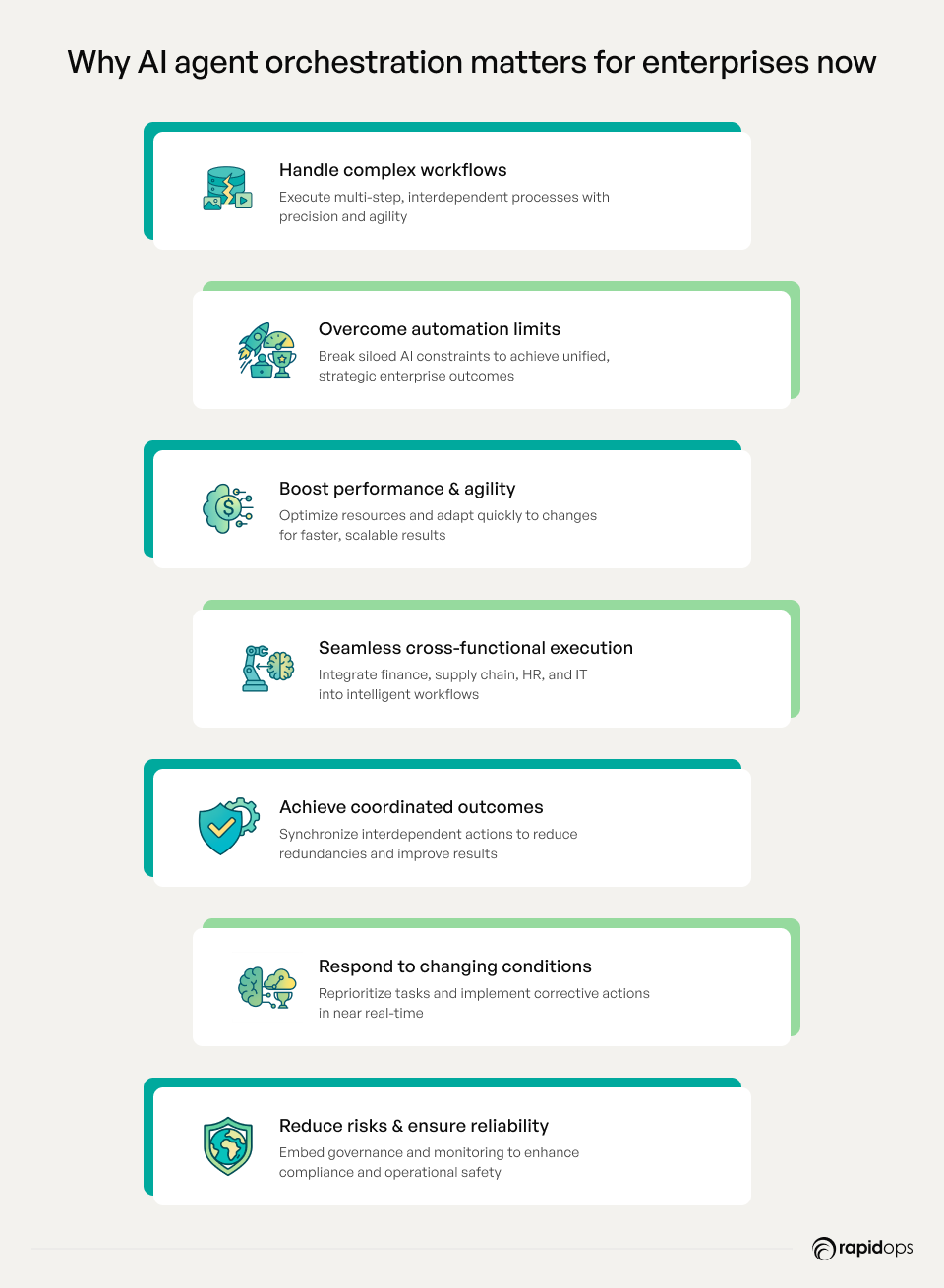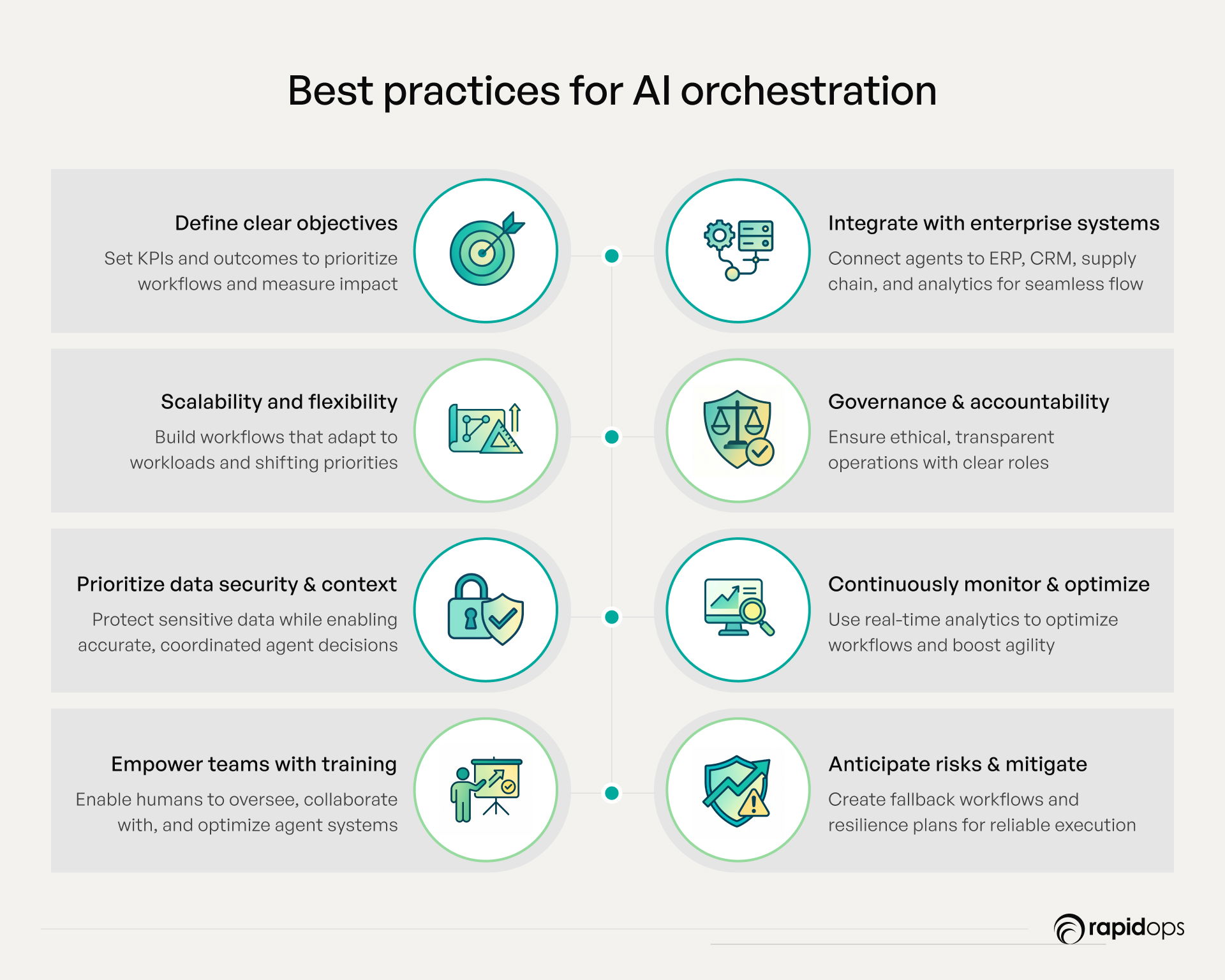Enterprise automation has evolved in waves: mechanization, digitalization, and most recently, software-driven workflows. Each increased efficiency but left a persistent challenge: fragmentation. Systems became faster yet more siloed, and automated processes often remained disconnected. Leaders asked a critical question: how can isolated gains evolve into an intelligent, enterprise-wide ecosystem?
The next leap came with AI. Unlike rule-based workflows, AI brought adaptability, learning from data, anticipating outcomes, and making decisions that extend automation’s reach. Building on this, enterprises are embracing AI agents autonomous, task-focused systems that act independently while collaborating across functions. Together, they represent the evolution from static workflows to dynamic, intelligent automation.
The challenge is urgent. Organizations embedding AI across operations achieve 30–40% productivity gains, and Gartner predicts that by 2026, more than 80% of enterprises will rely on AI agents to manage critical workflows. Yet deploying more agents alone doesn’t guarantee transformation; the real value emerges when they work together.
AI agent orchestration makes this possible. Dozens of specialized agents optimizing supply chains, engaging customers, managing compliance, and forecasting demand deliver incremental improvements individually. Orchestrated coordinated, connected, and aligned, they unlock exponential value: adaptive operations, faster decisions, and resilient enterprises.
More capabilities alone won’t drive results are your AI agents collaborating? Orchestrated intelligence enables faster, data-driven decisions, agile operations, and enterprise-wide impact. This blog explores why orchestration matters and how it transforms automation.
Understanding AI agent orchestration
Definition & strategic importance
AI agent orchestration is the coordinated management of multiple autonomous AI agents working across an enterprise to achieve strategic outcomes. Unlike traditional automation, which executes isolated tasks, or multi-agent systems, where agents operate independently without centralized oversight, AI agent orchestration ensures that every agent’s actions are aligned, complementary, and optimized for enterprise objectives.
Think of it like a well-run operations command center: each team (agent) has specialized expertise, but only through real-time coordination and shared intelligence can the enterprise respond swiftly, optimize outcomes, and reduce operational friction. Similarly, orchestrated AI agents move beyond incremental improvements to deliver enterprise-wide impact, seamlessly connecting workflows across departments, geographies, and systems.
This coordination transforms AI from a set of siloed tools into a strategic enabler, allowing enterprises to embed intelligence into every operational layer. For executives, this shift is critical: it turns AI investment from a collection of point solutions into a scalable, adaptive, and outcome-driven ecosystem.
Enterprise relevance & impact
The strategic value of AI agent orchestration becomes tangible when applied to real-world enterprise scenarios:
- Customer support: Agents can handle inquiries autonomously, escalate complex issues to human agents, and dynamically learn from interactions, delivering faster, more personalized service at scale.
- Supply chain management: Coordinated AI agents optimize inventory, predict demand fluctuations, and manage logistics across multiple suppliers, reducing delays and operational costs.
- Finance workflows: Agents manage transaction validation, fraud detection, and compliance reporting in a synchronized manner, improving accuracy while minimizing manual oversight.
The measurable benefits are compelling: increased efficiency, improved scalability, higher accuracy, faster decision-making, and a significant reduction in operational friction. Organizations that orchestrate AI agents effectively move from reactive to proactive operations, creating resilience in volatile markets and unlocking new strategic opportunities.
Evolution: From automation to orchestration
The rise of AI agent orchestration reflects a natural evolution in enterprise automation:
- RPA (Robotic Process Automation): Focused on task-level automation, RPA digitized repetitive manual processes but remained siloed.
- Intelligent automation: Introduced AI capabilities to handle cognitive tasks, enabling partial decision-making but often confined to specific workflows.
- AI agent orchestration: Moves beyond isolated automation to coordinated, enterprise-wide intelligence, aligning multiple AI agents to drive strategic outcomes and operational agility.
This progression highlights a fundamental shift: enterprises are no longer seeking isolated efficiency gains; they are building integrated, intelligent ecosystems. AI agent orchestration is not just a technology layer; it is a strategic framework that enables smarter, scalable, and adaptive operations across the entire enterprise.
Core components of AI agent orchestration
AI agent orchestration delivers value only when its foundational components work together seamlessly. Understanding these elements allows enterprises to design systems that are intelligent, resilient, scalable, and aligned with strategic objectives.

Orchestration engine
The orchestration engine is the central platform the “brain” of the system. It coordinates the infrastructure, manages agent registration, maintains workflow definitions, and ensures that all agents operate within a unified framework. It provides the backbone for structured automation at scale.
Agent registry
This component catalogs all AI agents, recording their capabilities, operational status, and specialized roles. It serves as a reference point for the orchestration engine, enabling dynamic discovery and alignment of agents with the architecture, ensuring the system always knows “who can do what.”
Workflow repository
The workflow repository stores all predefined processes, task sequences, and dependencies. It acts as the blueprint for orchestrated automation, providing a structured map of how the system is designed to operate and ensuring consistency and reliability across enterprise functions.
Integration layer
The integration layer connects the orchestration system to enterprise applications, databases, and external services. It forms the connective tissue of the architecture, allowing data and instructions to flow seamlessly between agents and systems without friction or siloed processes.
Monitoring & analytics module
This module captures system-level data, metrics, and operational logs, providing visibility into the health and performance of the orchestration ecosystem. It is an architectural component that ensures leaders and the system itself have continuous insight into the orchestration framework.
Governance & security framework
Built into the architecture, this framework ensures compliance, security, and auditability. It enforces access controls, maintains audit trails, and embeds regulatory and ethical safeguards directly into the system, providing structural confidence that the orchestration operates safely and reliably.
Feedback & learning infrastructure
This component stores operational data and enables structured learning pipelines that feed back into the system architecture. It ensures that the orchestration ecosystem can evolve, scale, and refine itself over time without structural overhaul.
Why enterprises need AI agent orchestration today
In 2025, enterprises face unprecedented operational complexity, accelerated market dynamics, and rising expectations from customers and stakeholders. Traditional automation and siloed AI implementations are no longer sufficient. AI agent orchestration addresses these challenges, enabling organizations to move from fragmented efficiency gains to coordinated, enterprise-wide intelligence.

1. Handle complex, multi-step workflows efficiently
Modern enterprise workflows are rarely linear. They involve multiple steps, conditional paths, and dependencies across teams, systems, and processes. AI agent orchestration ensures these workflows are executed with precision by dynamically allocating tasks to the right agents, monitoring progress in real time, and adjusting actions based on changing priorities.
This level of orchestration transforms operational execution from reactive to proactive. Enterprises can handle large-scale, interdependent processes such as order-to-cash cycles, cross-functional project delivery, or regulatory reporting without bottlenecks, delays, or human error.
2. Overcome the limitations of traditional automation
Traditional automation, including RPA and task-level AI, delivers incremental efficiency gains but struggles to scale across the complexity of the enterprise. Its siloed nature leads to fragmented outcomes and inconsistent performance.
AI agent orchestration transcends these limitations by enabling agents to collaborate, share insights, and align actions toward strategic objectives. It establishes a unified operational layer where intelligence is distributed yet synchronized, transforming AI from a tactical tool into a strategic driver of enterprise performance.
3. Improve operational performance and business agility
Performance in modern enterprises is not just measured by speed or cost reduction, but also by adaptability and resilience. Orchestrated AI agents continuously analyze workflows, identify inefficiencies, and optimize resource allocation, enabling enterprises to respond quickly to internal and external changes.
The agility gained through orchestration translates into faster product launches, more responsive customer engagement, and the ability to scale operations efficiently across multiple markets. This positions enterprises to seize opportunities ahead of competitors and navigate disruption with confidence.
4. Enable seamless execution across key enterprise functions
Enterprises operate across diverse functions, including finance, supply chain, HR, IT, and customer engagement, each with distinct systems, data models, and operational rules. AI agent orchestration integrates these functions into a cohesive, intelligent workflow layer, ensuring that tasks, decisions, and insights flow seamlessly across departments and teams.
The result is not only operational efficiency but also strategic alignment: initiatives are executed in harmony, outcomes are measurable, and resources are optimized across the enterprise.
5. Achieve coordinated outcomes across departments
Orchestrated intelligence ensures that interdependent actions complement one another. For example, decisions in supply chain planning are synchronized with inventory management, finance approvals, and customer fulfillment, creating a unified operational response.
This coordination reduces redundancies, prevents conflicting actions, and drives predictable, enterprise-wide outcomes. It also establishes a foundation for continuous process improvement, where learning from one function informs improvements across others.
6. Respond quickly to changing market or operational conditions
Market dynamics are no longer predictable. AI agent orchestration enables enterprises to respond in near real-time to evolving conditions. Agents can reprioritize tasks, escalate critical issues, and implement corrective actions automatically.
This capability allows organizations to handle supply chain disruptions, shifting customer demand, or regulatory changes with minimal manual intervention ensuring continuity, competitiveness, and faster decision cycles.
7. Reduce operational risks and ensure reliable execution
AI agent orchestration embeds governance, compliance, and monitoring directly into workflows. By maintaining end-to-end visibility and control, enterprises mitigate operational risks, detect anomalies early, and ensure regulatory adherence.
Reliable execution reduces dependency on human intervention for oversight, enhances auditability, and strengthens enterprise resilience. In high-stakes environments such as finance and logistics, this reliability becomes a differentiator, safeguarding both operational performance and reputation.
How AI agent orchestration works in practice
AI agent orchestration transforms fragmented, standalone automation into a connected, intelligent ecosystem, where multiple AI agents collaborate seamlessly to drive enterprise-wide outcomes. By combining structured processes, robust system integration, and continuous optimization, orchestration ensures every agent operates in harmony, delivering measurable impact and strategic value across the organization.
1. Assign and prioritize tasks to the right AI agents
Effective orchestration begins with intelligent task assignment. Each AI agent is evaluated based on its capabilities, expertise, and workload. Tasks are prioritized according to business objectives, deadlines, and dependencies, ensuring that the right agent handles the right work at the right time.
This dynamic allocation maximizes agent efficiency, prevents bottlenecks, and ensures that high-priority tasks are addressed immediately, while routine or lower-priority tasks are managed seamlessly in parallel.
2. Coordinate multiple agents to work together efficiently
Agent coordination is the backbone of orchestration. Orchestration platforms manage dependencies, synchronize actions, and prevent conflicts between agents. By defining sequences, escalation paths, and communication protocols, enterprises ensure that multiple agents operate as a cohesive unit rather than independent silos.
This coordination guarantees that complex workflows involving multiple agents, whether spanning departments, geographies, or functional areas, are executed reliably and consistently.
3. Integrate orchestration with enterprise systems
AI agent orchestration achieves its full potential when integrated with core enterprise systems like ERP, CRM, HR platforms, and analytics tools. System integration allows agents to access and update real-time data, trigger workflows, and share insights across the organization.
Seamless integration eliminates data silos, aligns operational processes, and ensures that agent actions are fully synchronized with enterprise priorities, policies, and systems.
4. Monitor performance and continuously optimize workflows
Continuous performance monitoring is essential to maintain operational excellence. Orchestration platforms track agent performance, workflow efficiency, and process outcomes in real time.
Insights derived from monitoring enable continuous optimization, adjusting task allocation, refining coordination protocols, and identifying areas for improvement. This feedback loop enhances accuracy, responsiveness, and overall enterprise efficiency.
5. Ensure governance, compliance, and risk management
Governance is embedded throughout orchestrated AI operations. Orchestration frameworks enforce compliance, risk management, and auditability, including role-based access, policy adherence, and ethical AI safeguards.
By maintaining end-to-end control and visibility, enterprises reduce operational risk, ensure regulatory compliance, and provide leadership with confidence that critical processes are executed reliably and ethically.
Use cases of AI agent orchestration
1. Customer service automation
AI agent orchestration enables enterprises to coordinate multiple agents managing chatbots, ticket routing, and sentiment analysis. By unifying these functions, organizations ensure consistent, personalized, and responsive customer experiences across channels. Agents work collaboratively to prioritize urgent issues, route queries to the right resources, and continuously learn from interactions, improving resolution times and satisfaction. For executives, this orchestration translates into enhanced brand loyalty, reduced operational overhead, and scalable customer support capabilities without increasing human workload.
2. Inventory and stock management
Orchestrated AI agents monitor inventory levels, predict replenishment needs, and identify potential stockouts before they occur. By coordinating these activities, enterprises can maintain optimal inventory, reduce carrying costs, and prevent lost sales due to shortages. Agents integrate data from sales trends, supply chains, and warehouse systems to provide real-time insights, enabling proactive decision-making. This ensures that leaders have full visibility into stock positions while operations remain agile, accurate, and cost-efficient across multiple locations and product lines.
3. Demand forecasting and production planning
AI agent orchestration allows agents to analyze sales trends, historical demand, and production capacities collaboratively. Coordinated agents optimize resource allocation, production schedules, and inventory buffers, ensuring operations align with market needs. This reduces overproduction, minimizes waste, and improves supply chain responsiveness. For enterprise leaders, it provides a clear, data-driven view of future demand, enabling proactive planning, faster time-to-market, and better alignment between sales, manufacturing, and logistics teams, ultimately supporting profitability and operational efficiency.
4. Warehouse operations automation
In warehouses, orchestrated agents handle picking, packing, quality inspections, and real-time audits collaboratively. By managing these tasks in a coordinated workflow, enterprises streamline operations, reduce errors, and accelerate order processing. Agents can dynamically adjust to workload fluctuations, optimize task sequences, and ensure compliance with quality standards. For decision-makers, orchestration enables efficient warehouse management at scale, improving throughput, reducing operational costs, and enhancing reliability across multiple distribution centers without compromising accuracy or speed.
5. Route planning and logistics coordination
AI agent orchestration coordinates agents managing delivery routes, vehicle assignments, and transportation resources. By analyzing traffic data, delivery priorities, and fleet capacity in real time, agents optimize schedules and routes to maximize efficiency, reduce fuel costs, and improve on-time delivery rates. Executives benefit from enhanced visibility into logistics operations, reduced operational risk, and the ability to respond rapidly to disruptions or changing delivery requirements, ensuring customers receive reliable service while maintaining cost-effective transportation operations.
6. Order management and fulfillment
Orchestrated AI agents handle order processing, status tracking, and multi-channel delivery coordination seamlessly. By aligning agents across ERP, CRM, and warehouse systems, enterprises achieve faster, error-free fulfillment and real-time visibility into order status. Coordination ensures that orders are prioritized correctly, exceptions are flagged promptly, and resources are allocated efficiently. For leaders, this orchestration translates into improved customer satisfaction, reduced delays, and scalable operations that support growth while maintaining operational excellence across sales channels.
These use cases demonstrate how AI agent orchestration converts isolated automation into cohesive, outcome-driven enterprise capabilities. From customer service to logistics, orchestrated agents deliver efficiency, consistency, and strategic value at scale. The next section explores how organizations can implement AI agent orchestration successfully, ensuring maximum return on investment and sustainable operational impact.
Best practices for successful AI agent orchestration
Building effective multi-agent orchestration requires more than deploying advanced agent systems tools. It demands a strategic, enterprise-wide approach that aligns operations, technology, and people to unlock measurable impact. The following practices help leaders orchestrate multi-agent systems at scale, enabling intelligent routing of tasks, seamless collaboration, and context-driven decision-making across the enterprise.

1. Define clear objectives and measurable outcomes
Orchestration delivers the most value when multi-agent systems are aligned to well-defined goals. Establishing KPIs tied to efficiency, accuracy, or resilience ensures that complex tasks performed by agents generate tangible business outcomes. Clear targets also help prioritize high-impact workflows and guide continuous optimization.
2. Integrate seamlessly with enterprise systems
Multi-agent orchestration succeeds when agent systems tools connect fluidly with ERP, CRM, supply chain, and analytics platforms. Integration ensures intelligent routing of tasks and real-time data exchange, providing leaders with a unified operational view while reducing process silos.
3. Design for scalability and flexibility
Enterprises evolve, and so must orchestration frameworks. Building workflows that scale across geographies and business units allows multi-agent systems to manage rising workloads and adapt to new priorities without losing performance. Flexibility ensures orchestration can extend to emerging use cases as enterprises mature.
4. Establish governance, compliance, and accountability
Complex tasks handled by orchestrated agents require trust and oversight. Strong governance structures define roles, enforce compliance, and ensure orchestrated intelligence operates transparently. This gives executives confidence that multi-agent orchestration is ethical, auditable, and aligned with strategic objectives.
5. Prioritize data security and context management
Data is the foundation of orchestration. Robust security measures encryption, access controls, and global compliance, protect sensitive information. Equally critical is context management, which enables agents to interpret workflows correctly, share insights accurately, and make coordinated decisions without errors.
6. Continuously monitor and optimize performance
Real-time monitoring strengthens multi-agent orchestration by identifying inefficiencies and adapting workflows dynamically. Intelligent routing and performance analytics ensure agents collaborate effectively, improve over time, and sustain enterprise agility at scale.
7. Empower people through training and change management
Even in advanced multi-agent systems, human teams play a central role. Structured training and change management prepare employees to oversee, collaborate with, and optimize orchestrated agents. This accelerates adoption and ensures orchestration complements human judgment.
8. Anticipate risks and establish mitigation strategies
Managing complex tasks across multi-agent systems introduces operational and technological risks. Mitigation strategies fallback workflows, compliance audits, and resilience planning, ensure continuity and reliability, even in dynamic or disrupted environments.
By adopting these best practices, enterprises can transform multi-agent orchestration from a tactical initiative into a scalable, enterprise-wide capability. With intelligent routing, context management, secure data practices, and empowered teams, organizations are positioned to orchestrate complex tasks seamlessly and unlock new levels of operational intelligence.
Making AI orchestration work for your organization
Now that you know why AI agent orchestration is the key to enterprise automation success, it’s time to put that insight into action. Many leaders face the frustration of fragmented workflows, disconnected AI initiatives, and rising expectations from customers and markets. Even significant automation investments can fall short without the right orchestration strategy to tie everything together.
At Rapidops, we help organizations connect AI agents across workflows, streamline processes, and deliver measurable outcomes. With our strategic guidance, proven orchestration frameworks, and hands-on implementation expertise, we transform isolated automation efforts into a seamless, intelligent system that drives efficiency, faster decision-making, and meaningful innovation.
Implementing AI agent orchestration involves critical, high-impact steps that benefit from expert guidance. Schedule a conversation with one of our AI experts today to start building intelligent, resilient, and scalable operations tailored to your enterprise.
Frequently Asked Questions
How do AI agents collaborate across departments?
AI agents collaborate across departments by forming an orchestrated, multi-agent system that aligns tasks, data, and decision-making in real time. Each agent specializes in specific functions finance, supply chain, HR, IT, or customer engagement, while sharing insights and coordinating actions through seamless integration with enterprise systems. This enables complex, cross-functional workflows to execute efficiently, reduces bottlenecks, ensures consistency, and allows departments to respond rapidly to changing priorities, creating unified, strategic outcomes across the organization.
What are the real business benefits of orchestrated AI agents?
Orchestrated AI agents enable enterprises to move beyond isolated AI or single-agent systems by coordinating multiple AI agents and specialized agents across complex tasks and workflows. Through intelligent routing, context management, and seamless integration with existing systems, orchestrated agents improve operational performance, enhance decision-making, and reduce human intervention. By leveraging multi-agent orchestration, AI systems deliver scalable, adaptive intelligence that aligns actions with strategic objectives, ensuring consistent outcomes, higher efficiency, and measurable business impact.
How does orchestration unify fragmented enterprise workflows?
AI agent orchestration unifies fragmented enterprise workflows by creating a coordinated layer where multiple agents operate in sync across departments and systems, thereby enhancing overall efficiency and productivity. By integrating data, tasks, and decision-making, orchestration ensures that complex, multi-step processes such as order-to-cash, project delivery, or regulatory compliance flow seamlessly. This approach eliminates silos, reduces redundancies, maintains consistency, and enables enterprises to achieve predictable, enterprise-wide outcomes with greater efficiency and reliability.
What workflows are best suited for AI agent orchestration?
Workflows that are complex, multi-step, and involve dependencies across teams, systems, or business units are ideal for AI agent orchestration. Examples include order-to-cash cycles, cross-functional project execution, supply chain management, regulatory reporting, and customer engagement processes. Orchestration ensures these workflows are executed with precision, dynamically allocating tasks to the right agents, enabling seamless integration, reducing errors, and delivering consistent, measurable outcomes across the enterprise.
What role does real-time monitoring play in AI agent orchestration?
Real-time monitoring is critical for AI agent orchestration, enabling enterprises to track the progress of complex, multi-agent workflows continuously. It allows agents to detect bottlenecks, reprioritize tasks dynamically, and respond immediately to operational changes or unexpected disruptions. By providing actionable insights across departments and systems, real-time monitoring ensures coordinated execution, reduces errors, maintains consistency, and enhances the agility and reliability of enterprise operations.
How can my organization get started with AI agent orchestration efficiently?
To start efficiently, organizations should first identify high-value workflows that will benefit most from automation and AI collaboration. Next, design orchestrated processes that define task allocation, dependencies, and integration across systems and departments. Implement AI agents gradually, using frameworks that enable seamless collaboration, real-time monitoring, and continuous optimization. Embedding governance, compliance, and measurable KPIs from the outset ensures operations remain reliable, scalable, and aligned with strategic business objectives.

Rahul Chaudhary
Content Writer
With 5 years of experience in AI, software, and digital transformation, I’m passionate about making complex concepts easy to understand and apply. I create content that speaks to business leaders, offering practical, data-driven solutions that help you tackle real challenges and make informed decisions that drive growth.
What’s Inside
- Understanding AI agent orchestration
- Core components of AI agent orchestration
- Why enterprises need AI agent orchestration today
- How AI agent orchestration works in practice
- Use cases of AI agent orchestration
- Best practices for successful AI agent orchestration
- Making AI orchestration work for your organization

Let’s build the next big thing!
Share your ideas and vision with us to explore your digital opportunities
Similar Stories
- AI
- 4 Mins
- September 2022

- AI
- 9 Mins
- January 2023


Receive articles like this in your mailbox
Sign up to get weekly insights & inspiration in your inbox.

